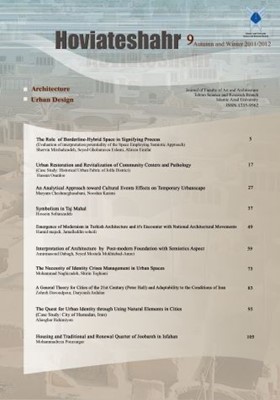Housing and Traditional and Renewal Quarter of Joobareh in Isfahan
Subject Areas : architecture
1 - Department of Architecture ,Islamic Azad University , Tehran, Central Branch , IRAN
Keywords:
Abstract :
Physical and functional study and investigation of old cities is a ground maker for taking appropriate decisions for revitalization of historical textures besides clarifying vague and unknown corners of history and culture of each country which plays important role in the future development of cities. The objective of this study is provision of an approach along creation of a vivid urban region and as a result provision of requirements of its residents by saving the historical and cultural identity of neighborhood that along this Joobareh neighborhood was selected for providing this pattern and ideogram due to having strong potentials as a remarkable example. Proximity of the great mosque with the entrance gate of this neighborhood and covered communication path inside it and also the connection of water channels extracted from Zayandehroud River for drinking are all indicative of democracy in the urbanization of the past time. This essay is derived from the research for renewal quarter of Joobareh in Isfahan. Iranian historical cities are combined of retail elements. Quarter, bazaar, mosque and organ are known as their main elements of them and other small spaces of it are local bazaar, tekieh, hosseinieh,minaret, cistern and passages.Meanwhile the quarter of Joobareh as a self-sufficient element has an independent identity and act as a public space. Each quarter has its administrative, social, cultural, economical role in an inseparable part of historical city. In Joobareh neighborhood there is no evidence of connecting path of bazaar and its relation with old square and the great mosque and the streets constructed around the neighborhood and its commercial skin have transformed that neighborhood center to an abandoned island due to lack or limitation of urban services. On the other hand, by settlement of migratory population and also separation of residential houses to several units the fatigueness coefficient in this neighborhood is increased. Other historical valuable buildings such as Menorah and entrance gate of the neighborhood, café,temple and water reservoir have thoroughly disappeared from the image of Joobareh neighborhood and if they have remained are under destruction. Among them, a few number are repaired by endeavor of Cultural Heritage Organization, however due to being enclosed and seclusion of the neighborhood they have no attraction for visitors. At the end,in order to rehabilitate Joobareh neighborhood,following issues are recommended: Systematic programming and study by the subject of Neighborhood revitalization. Revival of existing system of neighborhood and revitalization of semi-closed system of that. Saving historical values and improvement and its spatial and functional revitalization. Registration of neighborhood population and limited development of that by considering the per capita ratios. Rehabilitation and revitalization of neighborhood origins and removal of social damages. Improving the economical situation and the function of neighborhood via activating economic section and its potentials. Spatial organization of neighborhood and creation of traffic facilities and provision of urban services. Identity giving to neighborhood by creation of architecture and creation of a set of urban elements that can help revitalization of old texture.
فهرست منابع :
1-احمد اصلانی1383 . بافت قدیم بی بدیل و تکرار ناپذیر. مجله شهرداریها، سال ششم، شماره 70
2-محمد حسین بوچانی، 1383. نوسازی بافت کهن قزوین آزمونی برای مدیریت شهری.مجله شهرداری ها، سال ششم، شماره 70
3- احمدپوراحمد، علی شماعی، 1383.تحلیلی بر سیاست ها و برنامه های بهسازی و نوسازی شهری در برنامه های توسعه ی کشور، فصلنامه پژوهش های جغرافیایی، شماره 49.
4- محمدرضا حائری. 1368. طراحی از کالبد شهر ایرانی، بررسی گونه شناسانه بافت شهری در قرن جهاردهم هجری خلاصه مقالات تداوم حیات در بافت قدیمی شهرهای ایران، تهران.
5- غلام حسین حیدری تفرشی، و دیگران 1381 . نگرش نوین به سازمان مدیریت در جهان امروز. انتشارات فراشناختی اندیشه، تهران.
6- کرامت اله زیاری، 1382 . برنامه ریزی شهرهای جدید. انتشارات سمت، تهران.
7- سازمان مدیریت و برنامه ریزی کشور،پیوست قانون برنامه اول توسعه اقتصادی اجتماعی وفرهنگی جمهوری اسلامی ایران. 1368-72 .
8- سید محسن حبیبی شهرسازی تخیلات و واقعیات،دانشگاه تهران 1375.
9- حسین خلیل آباد کلانتری ،حسین حاتمی نژاد. 1385 . برنامه ریزی مرمت بافت تاریخی شهر یزد. انتشارات فراگستر.
10- حمید ماجدی ، 1389 توسعه های شهری امروز ، بافت های فرسوده آینده ، مجله هویت شهر سال چهارم شماره 6.
_||_

